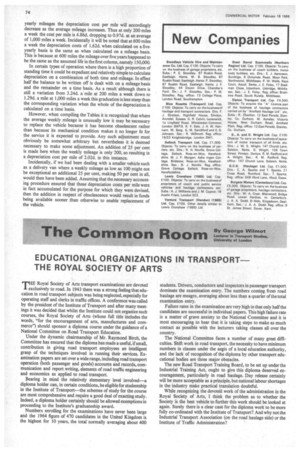The Common Roo
Page 76

If you've noticed an error in this article please click here to report it so we can fix it.
By George Wilmot
niLecturer in Transport Studies, University of London
EDUCATIONAL ORGANIZATIONS IN TRANSPORT THE ROYAL SOCIETY OF ARTS
Fr HE Royal Society of Arts transport examinations are devoted exclusively to road. In 1943 there was a strong feeling that education in road transport subjects was being neglected, especially for operating staff and clerks in traffic offices. A conference was called by the president of the Institute of Transport and after many meetings it was decided that whilst the Institute could not organize such courses, the Royal Society of Arts (whose full title includes the words, "for the encouragement of arts, manufactures and commerce") should sponsor a diploma course under the guidance of a National Committee on Road Transport Education.
Under the dynamic chairmanship of Mr, Raymond Birch, the Committee has ensured that the diploma has made a useful, if small, contribution in giving road transport employees an intelligent grasp of the techniques involved in running their services. Examination papers are set over a wide range, including road transport operation (both passenger and goods) accounts and records, communication and report writing, elements of road traffic engineering and economics as applied to road transport.
Bearing in mind the relatively elementary level involved—a diploma holder can, in certain conditions, be eligible for studentship in the Institute of Transport—the schemes of study for the course are most comprehensive and require a good deal of exacting study. Indeed, a diploma holder certainly should be allowed exemptions in proceeding to the Institute's graduateship award.
Numbers enrolling for the examinations have never been large and the 1964 figure of 470 candidates in the United Kingdom is the highest for 10 years, the total normally averaging about 400 students. Drivers, conductors and inspectors in passenger transport dominate the examination entry. The numbers coming from road haulage are meagre, averaging about less than a quarter of the total examination entry.
Failure rates in the examination are very high in that only half the candidates are successful in individual papers. This high failure rate is a matter of grave anxiety to the National Committee and it is most encouraging to hear that it is taking steps to make as much contact as possible with the lecturers taking classes all over the country.
The National Committee faces a number of many great difficulties. Shift work in road transport, the necessity to have minimum numbers in classes under the aegis of a local education authority, and the lack of recognition of the diploma by other transport educational bodies are three major obstacles.
The new Road Transport Training Board, to be set up under the Industrial Training Act, ought to give this diploma deserved encouragement, particularly in road haulage. Day release certainly will be more acceptable as a principle, but national labour shortages in the industry make practical translation doubtful.
While recognizing the devoted work of the administration in the Royal Society of Arts, I think the problem as to whether the Society is the best vehicle to further this work should be looked at again. Surely there is a clear case for the diploma work to be more fully co-ordinated with the Institute of Transport? And why not the Industrial Transport Association (on the road haulage side) or the Institute of Traffic Administration?




















































































































